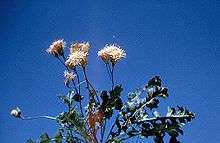Acourtia
Acourtia is a genus of flowering plants composed of the desertpeonies. It is part of the daisy family and was first described as a genus in 1830.[4][5][6]
| Desert-peonies | |
|---|---|
 | |
| Acourtia runcinata | |
| Scientific classification | |
| Kingdom: | |
| (unranked): | |
| (unranked): | |
| (unranked): | |
| Order: | |
| Family: | |
| Subfamily: | |
| Tribe: | |
| Genus: | Acourtia |
| Synonyms[3] | |
| |
Plants in this genus are native to the Southwestern United States (California to Texas) and Mesoamerica.[7] They are diverse in appearance. The flowers are usually white, pink, or purple.[3][8][9] Their flower heads are usually composed of only disc florets, though some are long and look like ray florets.
Species
Accepted species:[10]
- Acourtia belizeana
- Acourtia bravohollisiana
- Acourtia butandae
- Acourtia caltepecana
- Acourtia carpholepis
- Acourtia carranzae
- Acourtia ciprianoi
- Acourtia cordata
- Acourtia coulteri
- Acourtia cuernavacana
- Acourtia dieringeri
- Acourtia discolor
- Acourtia dissiticeps
- Acourtia dugesii
- Acourtia durangensis
- Acourtia elizabethiae
- Acourtia erioloma
- Acourtia fragrans
- Acourtia fruticosa
- Acourtia gentryi
- Acourtia glandulifera
- Acourtia glomeriflora
- Acourtia gracilis
- Acourtia grandifolia
- Acourtia guatemalensis
- Acourtia hebeclada
- Acourtia hidalgoana
- Acourtia hintoniorum
- Acourtia hondurana
- Acourtia hooveri
- Acourtia huajuapana
- Acourtia humboldtii
- Acourtia intermedia
- Acourtia joaquinensis
- Acourtia lepidopoda
- Acourtia lobulata
- Acourtia longifolia
- Acourtia lozanii
- Acourtia macrocephala
- Acourtia macvaughii
- Acourtia matudae
- Acourtia mexiae
- Acourtia michoacana
- Acourtia microcephala
- Acourtia moctezumae
- Acourtia molinana
- Acourtia moschata
- Acourtia nana
- Acourtia nelsonii
- Acourtia nudicaulis
- Acourtia nudiuscula
- Acourtia oaxacana
- Acourtia ovatifolia
- Acourtia oxylepis
- Acourtia palmeri
- Acourtia parryi
- Acourtia patens
- Acourtia pilulosa
- Acourtia pinetorum
- Acourtia platyphylla
- Acourtia platyptera
- Acourtia potosina
- Acourtia pringlei
- Acourtia pulchella
- Acourtia purpusii
- Acourtia queretarana
- Acourtia reticulata
- Acourtia runcinata
- Acourtia rzedowskii
- Acourtia scapiformis
- Acourtia scaposa
- Acourtia simulata
- Acourtia sinaloana
- Acourtia souleana
- Acourtia tenoriensis
- Acourtia thurberi
- Acourtia tomentosa
- Acourtia turbinata
- Acourtia umbratalis
- Acourtia venturae
- Acourtia veracruzana
- Acourtia wislizeni
- Acourtia wrightii
- Acourtia zacatecana
gollark: No. Firewall EVERYTHING. Let no traffic pass.
gollark: 1.8ish years.
gollark: And no, I do not.
gollark: That... isn't a webserver?
gollark: Yeeeees. Ish.
References
- "Genus Acourtia". Taxonomy. UniProt. Retrieved 2010-02-18.
- "Genus: Acourtia D. Don". Germplasm Resources Information Network. United States Department of Agriculture. 1994-09-07. Archived from the original on 2009-05-06. Retrieved 2010-10-25.
- Flora of North America Vol. 19 Page 72, Acourtia D. Don
- Don, David. 1830. Transactions of the Linnean Society of London 16(2): 203–204 descriptions in Latin, commentary in English
- Tropicos, Acourtia D. Don
- Reveal, J. L. and R. M. King. 1973. Re-establishment of Acourtia D. Don (Asteraceae). Phytologia 27: 228–232
- Biota of North America Program 2013 county distribution maps
- Davidse, G., M. Sousa-Peña, S. Knapp & F. Chiang Cabrera. 2014. Asteraceae. 5(2): ined. In G. Davidse, M. Sousa Sánchez, S. Knapp & F. Chiang Cabrera (eds.) Flora Mesoamericana. Universidad Nacional Autónoma de México, México D.F..
- Nelson, C. H. 2008. Catálogo de las Plantas Vasculares de Honduras 1–1576. Secretaria de Recursos Naturales y Ambiente, Tegucigalpa
- The Plant List search for Acourtia
External links
![]()
![]()
This article is issued from Wikipedia. The text is licensed under Creative Commons - Attribution - Sharealike. Additional terms may apply for the media files.